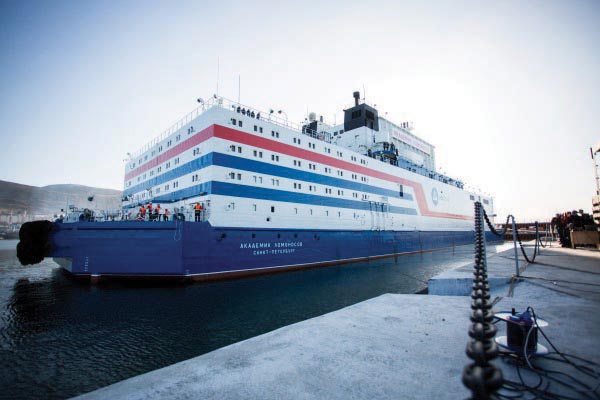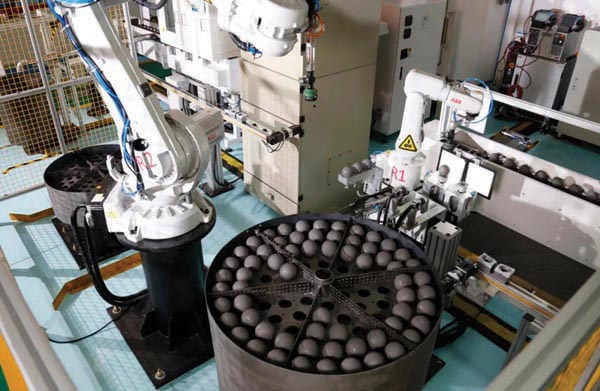A Closer Look at Two Operational Small Modular Reactor Designs
There are literally dozens of small modular reactor (SMR) and microreactor designs being developed by different companies around the world, and some of the work has been going on for decades. Yet, only two designs have actually been built and put into commercial operation. POWER takes a closer look at both of them.
Many nuclear power supporters have long thought small modular reactors (SMRs) would revolutionize the industry. Advocates expect SMRs to shorten construction schedules and bring costs down through modularization and factory construction. They often cite numerous other benefits that make SMRs seem like no-brainers, and yet, only two SMR designs have ever been built and placed in commercial operation.
The International Atomic Energy Agency (IAEA) publishes booklets biennially on the status of SMR technology. In the IAEA’s most recent booklet, it notes 25 land-based water-cooled SMRs and another eight marine-based water-cooled designs are under development globally. It also lists 17 high-temperature gas-cooled SMRs, eight liquid-metal-cooled fast-neutron-spectrum SMRs, 13 molten-salt SMRs, and 12 microreactors. If you do the math, that’s 83 SMR designs under development, but only the KLT-40S and HTR-PM are actually operational.
KLT-40S
The KLT-40S is a pressurized water reactor (PWR) that was developed in Russia. It is an advanced version of the KLT-40 reactor, which has been used in nuclear-powered icebreakers. The first KLT-40S units, and, to date, the only two of these units to enter commercial operation, were deployed in the Akademik Lomonosov—the world’s first purpose-built floating nuclear power plant (FNPP, Figure 1).
 |
|
1. The floating nuclear power plant (FNPP) Akademik Lomonosov is equipped with two KLT-40S reactors. The FNPP’s power capacity is 70 MW, while the heat capacity is 50 Gcal/hr. The plant’s length is 140 meters, width is 30 meters, and displacement is 21,500 tons. Courtesy: Rosatom |
Main Design Features. The KLT-40S has a capacity of 150 MWth or 35 MWe per module. Its nuclear steam supply system operating pressure is 12.7 MPa (1,842 psig). The reactor core inlet and outlet coolant temperatures are 280C and 316 C (536F and 601F), respectively. The unit uses uranium dioxide (UO2) pellets in silumin matrix for fuel with an enrichment of 18.6%. The core contains 121 fuel assemblies and operates on a 30- to 36-month refueling cycle. The design life is 40 years.
The reactor has a modular design with the core, steam generators (SGs), and main circulation pumps connected with short nozzles. The reactor has a four-loop system with forced and natural circulation, a pressurized primary circuit with canned motor-pumps and leak-tight bellow-type valves, a once-through coiled SG, and passive safety systems.
The KLT-40S’s thermal-hydraulic connections include an external pressurizer, accumulators, and separation heat exchanger. The pressurizer is not an integral part of the reactor system, and in this design, it is formed by one or more separate tanks, designed to accommodate changes in coolant volume, especially during reactor startup.
The core is cooled by water flowing from the core bottom to the top, in accordance with typical PWR core flow patterns. However, flow patterns between the core shroud and the reactor pressure vessel (RPV) inner walls differ significantly from conventional external loop PWR configurations. Once hot coolant exits the top of the core and enters any of the multiple SGs, it uses coaxial hydraulic paths wherein the cold and hot legs are essentially surrounding one another. As hot coolant enters the SG, it begins to transfer thermal energy with the fluid circulating in the secondary loop (secondary side of the SGs).
Deployment Details. The construction of a FNPP was first broached in 1998. The Russian Federation Ministry of Natural Resources approved the environmental impact assessment for the project in 2002. After several delays, the project was revived in 2006, but still moved at a fairly slow pace. It wasn’t until 2012 that Pevek, Chukotka, in Russia’s Far East, was selected as the site for final installation and Baltiysky Zavod JSC took charge of the construction, installation, testing, and commissioning for the first floating power unit (FPU).
Construction and testing of the FPU was completed in 2017 at the Baltic shipyard. In May 2018, the vessel was towed 4,000 kilometers (km), around Finland and Sweden, to Murmansk, completing the first leg of its journey to Pevek. Fuel loading was completed in Murmansk in October 2018. First criticality was achieved in November 2018, then in August 2019, the vessel embarked on the second leg of its journey—a distance of 4,700 km—towed by two tugboats to the Arctic port town of Pevek, where it was connected to the grid on Dec. 19, 2019. Akademik Lomonosov was fully commissioned on May 22, 2020, and it currently provides heat to the town of Pevek and supplies electricity to the regional Chaun-Bilibino power system.
HTR-PM
On Dec. 6, 2023, China National Nuclear Corp. announced it had commenced commercial operation of the high-temperature gas-cooled modular pebble bed (HTR-PM) reactor demonstrator. The HTR-PM project was constructed at a site in Rongcheng, Shandong Province, roughly midway between Beijing and Shanghai in eastern China. Touted as the world’s first commercially operational modular nuclear power plant with fourth-generation nuclear technology, the achievement marked an important milestone, transitioning the technology from experiments to the commercial market.
 |
|
2. Fuel loading at the Shidaowan high-temperature gas-cooled modular pebble bed (HTR-PM) in China began in the spring of 2021. It involved putting 870,000 spherical tri-structural isotropic (TRISO) particle fuel elements into the two small reactors that will drive a single 210-MWe turbine. Courtesy: China National Nuclear Corp. |
Main Design Features. The HTR-PM has a capacity of 2 x 250 MWth or 210 MWe. Each reactor is loaded (Figure 2) with more than 400,000 spherical fuel elements, or pebbles, each 60 millimeters in diameter, which is roughly the size of a tennis ball. Each pebble contains about seven grams of uranium fuel enriched to 8.5%.
Each HTR-PM module includes an RPV, graphite, carbon, and metallic reactor internals; a steam generator; a main helium blower; and a hot gas duct. The primary helium coolant works at a pressure of 7.0 MPa (1,015 psig) with a rated mass flowrate of 96 kilograms/second (761,918 lbm/hr). Helium coolant enters the reactor in the bottom area inside the RPV with an inlet temperature of 250C (482F). Helium coolant flows upward in the side reflector channels to the top reflector level where it reverses flow direction and flows into the pebble bed in a downward flow pattern.
Bypass flows are introduced into the fuel discharge tubes to cool the fuel elements and into the control rod channels for control rod cooling. Helium is heated in the active reactor core, then mixed to an average outlet temperature of 750C (1,382F). It then flows to the steam generator. The secondary steam normal operating pressure is 13.25 MPa (1,922 psig) and temperature is 567C (1,053F) at the steam turbine entrance.
The HTR-PM utilizes a continuous fuel loading and discharging system. The fuel elements drop into the reactor core from the central fuel-loading tube and are discharged through a fuel extraction pipe at the core bottom. Subsequently, the discharged fuel elements pass a burnup measurement device one by one. If a fuel sphere reaches the target burnup, it is discharged to the spent fuel storage tank, otherwise, it is re-inserted into the reactor to pass through the core again.
Deployment Details. The HTR-PM design has a long history, which began in 1992 when the Chinese government approved the construction of the 10-MWth pebble-bed high-temperature gas-cooled test reactor (HTR-10) at Tsinghua University’s Institute of Nuclear and New Energy Technology (INET). As the HTR-10 unit neared completion in 2001, the HTR-PM project was launched. HTR-10 ultimately achieved full power operation in 2003, and INET subsequently completed many experiments on the unit to verify crucial safety features and validate the design.
Meanwhile, the first concrete for the HTR-PM demonstration power plant was poured on Dec. 9, 2012. To support first-of-a-kind (FOAK) equipment manufacturing and design licensing, large-scale engineering test facilities were constructed. Fuel plant construction started in 2013. The following year, qualification irradiation tests of fuel elements were completed.
The civil work for the nuclear island buildings was completed in 2016 with the first of two reactor pressure vessels installed in March that year. The fuel plant reached its expected production capacity in 2017. Startup commissioning and testing of the primary circuit were finished by the end of 2020. The HTR-PM achieved first criticality in September 2021, and was ultimately grid connected on Dec. 20, 2021.
Spotty Results at Best
While it is laudable that these SMRs—the KLT-40S and HTR-PM—have been placed in commercial operation, their performance since entering service has come under fire. In The World Nuclear Industry Status Report 2023 (WNISR), a Mycle Schneider Consulting Project, co-funded by the German Federal Ministry for the Environment, Nature Conservation, Nuclear Safety, and Consumer Protection, it says both designs have operated at low capacity factors recently.
Concerning the Chinese HTR-PM, the WNISR says, “Between January and December 2022, the reactors operated for only 27 hours out of a possible maximum of 8,760 hours. In the subsequent three months, they seem to have operated at a load factor of around 10 percent.” The Russian units’ performance has been nearly as dismal. “The operating records of the two KLT-40S reactors have been quite poor. According to the IAEA’s PRIS [Power Reactor Information System] database, the two reactors had load factors of just 26.4 and 30.5 percent respectively in 2022, and lifetime load factors of just 34 and 22.4 percent. The reasons for the mediocre power-generation performance remain unclear,” the report says.
Meanwhile, the promises of shortened timelines and lower costs were not borne out by these projects. “The experience so far in constructing these two SMRs as well as estimates for reactor designs like NuScale’s SMR show that these designs are also subject to the historical pattern of cost escalations and time overruns. Those cost escalations do make it even less likely that SMRs will become commercialized, as the collapse of the Carbon Free Power Project involving NuScale reactors in the United States illustrated,” the WNISR says.
With that said, it should be noted that these were FOAK projects, and those rarely progress without hitches. If the lessons learned from these two completed dual-unit SMRs can be parlayed into future successes, the projects may yet prove to be incredibly valuable.
—Aaron Larson is POWER’s executive editor.